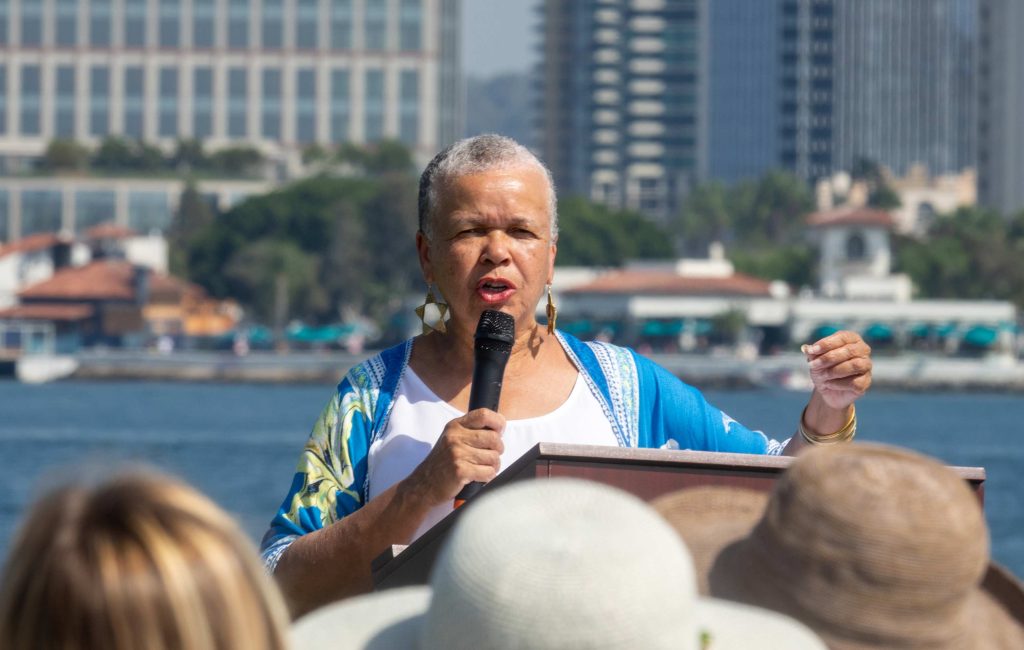On September 7, the Coronado Community Remembrance Coalition, the Coronado Historical Association, and the City of Coronado held a soil collection ceremony as part of EJI’s Community Remembrance Project to commemorate Alton Collier, who was lynched in California’s San Diego County on April 27, 1946.
The Coronado Community Remembrance Project was founded by historian Kevin Ashley and Dr. Fern Nelson. They welcomed dozens of community members to the ceremony at Centennial Park on the shores of Coronado Bay, where Alton Collier boarded the ferry from Coronado to San Diego.
He never reached the other side. “Alton walked here and didn’t walk back,” Dr. Nelson said as she patted sand collected at the site. “He lost his life because of hatred, evil, which still exists today. We just honor you, Alton. We’re sad you’re not here and that you didn’t get to finish your life.”
The soil collection event included coalition members Vickie Stone, David Grant-Williams, and Ruthie Grant-Williams, who spoke about Mr. Collier’s life and reminded attendees that no one was ever charged in his death.
The Lynching of Alton Collier
On April 27, 1946, a mob of white people, many of whom were Navy personnel, terrorized and lynched a young Black man named Alton Collier on the ferry from Coronado to San Diego. The mob cornered Mr. Collier, kicked, cursed at, and beat him, before ultimately knocking him off the boat into San Diego Bay, where he drowned. Although members of the mob were identified, no one was ever held accountable.
Mr. Collier was lynched when he was just 26 years old. Having grown up in Texas with five sisters and three brothers, he moved to California in 1944 with his wife, Georgia M. Collier. By 1946, he was employed at the Hotel del Coronado as a cement finisher. The night he was killed, he was traveling from the island to San Diego to pick up some clothing that he had purchased for himself and his wife.
At around 8 pm that night, Mr. Collier took his seat near the rear of the ferry. Most of the 30 passengers were Navy personnel, including two officers. Mr. Collier was one of only two Black people on board. As the boat departed Coronado at 8:20 pm, two drunken white sailors approached Mr. Collier and, unprovoked, began kicking him. A witness heard one of the sailors say, “There’s a n——r now.” When he moved to another seat without comment, the sailors apparently “resented [his] quiet mannerisms” and continued to threaten and assault him. Additional servicemembers soon joined in.
Mr. Collier tried to retreat but was cornered by the mob. Then, according to an eyewitness report, a man seized a boat hook and struck Mr. Collier, knocking him overboard. Mr. Collier was heard screaming as he plunged into the water.
Though “man overboard” was shouted and the ferry captain dispatched an unmanned lifeboat, they did not stop to rescue Mr. Collier, whose severely decomposed body was not recovered until a week later.
Police declined to launch a full investigation into Mr. Collier’s death. Even after his attackers admitted during a coroner’s inquest that they threatened, cursed at, and beat him without provocation, the coroner concluded there was “no evidence of violence” and, finding Mr. Collier had “voluntarily jumped to the sea,” officially ruled his death a suicide.
Mr. Collier’s widow, Georgia, hired Walter L. Gordon Jr., a renowned Black lawyer, to conduct an independent investigation, which determined that Mr. Collier was the victim of a “gang-up” attack by white sailors who knocked him off the boat with a blow from a boat hook. It also found that the sailors were “proud of their act.” Despite these findings, local officials refused to reconsider the cause of death.
Mrs. Collier sued the San Diego and Coronado Ferry Company for failing to “protect Alton Collier as a passenger on [the] boat against acts of violence by other passengers” and sued two white sailors, Freddie Leroy Johnson and Otis Reed Gilbert, for “acts of violence and assault and battery.” After the defendants argued that Mr. Collier’s own “negligence, recklessness, and carelessness…cause[d] himself to fall or voluntarily jump from the deck,” the lawsuit was dismissed. Mrs. Collier never received any redress for her husband’s death.
Mrs. Collier, as well as the Black lawyers and journalists who criticized the police investigation, demonstrated immense courage at a time when Black independence and resistance to exploitation often led to violent retaliation. Even when these efforts did not produce accountability for perpetrators of racial terror lynchings, the resilience of Black survivors and the entire Black community challenged the silence of white residents who failed to join their call for justice.

/
Soil collected in remembrance of Alton Collier.
Joel Ortiz
/
Grand nephew of Alton Collier, Larry Collier Hall (center), with Caroline Ashley and Coronado Community Remembrance Coalition co-chair Kevin Ashley.
Joel Ortiz
/
Coalition member Ruthie Grant-Williams shares facts about Alton Collier.
Joel Ortiz
/
Professor Starla Lewis speaks with EJI’s Brandon McRae after the soil collection ceremony.
Joel Ortiz
/
Professor Starla Lewis from San Diego Mesa College addresses the crowd.
Joel Ortiz
/
Local community youth musicians perform “Abide With Me” at the ceremony.
Joel OrtizLynching in America
Thousands of Black people were the victims of lynching and racial violence in the U.S. between 1865 and 1950. During this era, lynching emerged as the most notorious and public form of racial terrorism, used to enforce racial hierarchy and segregation. Many Black people were lynched following accusations of violating the social order or racial expectations, such as by arguing with a white person or asserting their dignity, autonomy, and freedom.
While the majority of lynchings were carried out in the South, the millions of Black Americans who moved to the Northeast, Midwest, and West to flee the South’s racial terrorism and segregation continued to be burdened by racial prejudice that left them highly vulnerable to mob violence.
Racial terror lynchings committed outside the South featured many of the same characteristics as Southern lynchings—which often went beyond hanging to include death by beating, drowning, and other horrific means—and were used to terrorize Black communities in order to maintain racial hierarchy.
Many of the names of lynching victims were not recorded and will never be known, but EJI has documented three African American victims of racial terror lynching killed in California during this era.
Community Remembrance Project
The Community Remembrance Project is part of our campaign to recognize the victims of lynching by collecting soil from lynching sites, erecting historical markers, and developing the Legacy Sites in Montgomery.
EJI believes that by reckoning with the truth of racial violence, communities can begin a necessary conversation that advances healing and reconciliation.